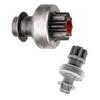Amardeep Auto Enterprises
Product Range
Fact Sheet
- Location:New Delhi, India
- Year of Establishment:2004
- Business Type:Manufacturer, Exporter
- Main Products:Starter Pinion,Self Starter Drives,Self Starter Pinion ,Starter
- Reviews & Rating:
Get Verified, Sell more with
- Buyer's trust
- Faster conversions
- Better Rankings
- More
Its Free
Verify NowAuto Starter System
A starter is an electric motor, pneumatic motor, hydraulic motor, or other device for rotating an internal-combustion engine so as to initiate the engine's operation under its own power.
- FOB PriceNA
- Min Order QuantityNA
- Payment TermsNA
Other Details
We offer automative self starter drives, which are available in varied specifications of teeth, clockwise and anticlockwise movement, length, splines, drive
OD. These starter drive are made from alloy steel using
cold forging process, which ensures efficient performance at client's
end.
The self starter drives that we offer
to Bosch are made of superior grade raw material to ensure optimum
performance at client's end
A starter is an electric motor, pneumatic motor, hydraulic motor, or other device for rotating an internal-combustion engine so as to initiate the engine's operation under its own power.
Before the advent of the starter motor, engines were started by various methods including wind-up springs, gunpowder cylinders, and human-powered techniques such as a removable crank handle which engaged the front of the crankshaft, pulling on an airplane propeller, or pulling a cord that was wound around an open-face pulley.
Originally, a hand-crank was used to start engines, but it was inconvenient, difficult, and dangerous to crank-start an engine. The behavior of an engine during starting is not always predictable. The engine can kick back, causing sudden reverse rotation. Many manual starters included a one-directional slip or release provision so that once engine rotation began, the starter would disengage from the engine. In the event of a kickback, the reverse rotation of the engine could suddenly engage the starter, causing the crank to unexpectedly and violently jerk, possibly injuring the operator. For cord-wound starters, a kickback could pull the operator towards the engine or machine, or swing the starter cord and handle at high speed around the starter pulley. Even though cranks had an overrun mechanism, when the engine started, the crank could begin to spin along with the crankshaft and potentially strike the person cranking the engine. Additionally, care had to be taken to retard the spark in order to prevent backfiring; with an advanced spark setting, the engine could kick back (run in reverse), pulling the crank with it, because the overrun safety mechanism works in one direction only.
Although users were advised to cup their fingers and thumb under the crank and pull up, it felt natural for operators to grasp the handle with the fingers on one side, the thumb on the other. Even a simple backfire could result in a broken thumb; it was possible to end up with a broken wrist, or worse. Moreover, increasingly larger engines with higher compression ratios made hand cranking a more physically demanding endeavour.
The first electric starter was installed on an Arnold, an adaptation of the Benz Velo, built 1896 in East Peckham, England by electrical engineer H. J. Dowsing
Images




